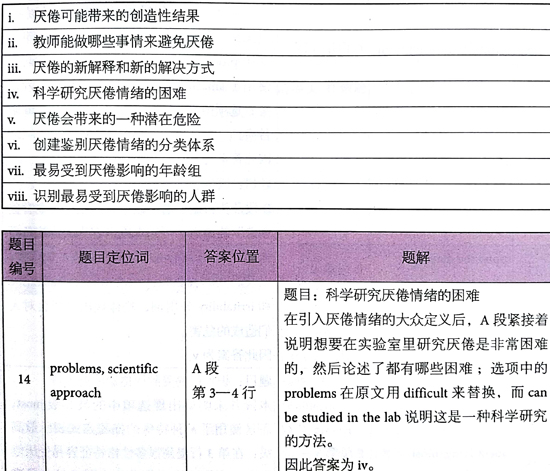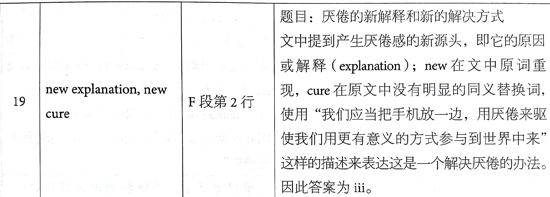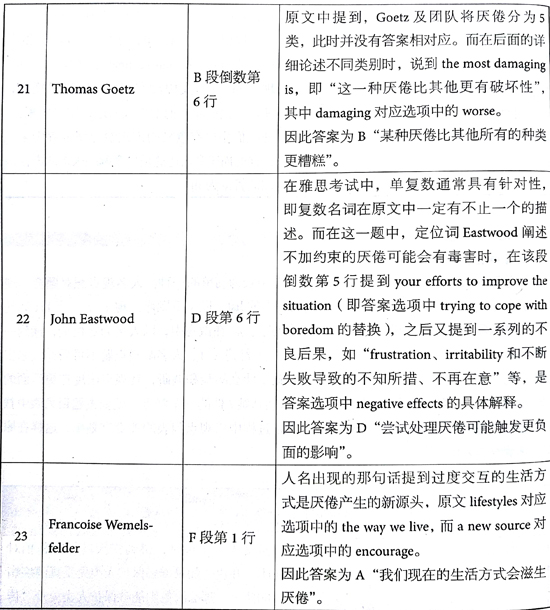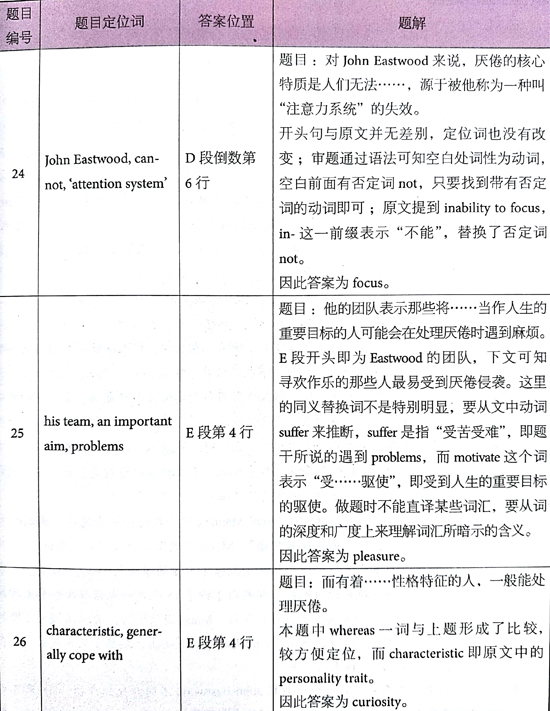剑桥雅思13Test1雅思阅读passage 2真题+解析
剑桥雅思13Test1雅思阅读passage 2真题+解析
相关阅读:剑桥雅思13Test1阅读passage2真题+翻译
| 体裁 | 说明文 |
| 主要内容 | 本文探讨了厌倦情绪的分类及其科学上的意义。 |
| 结构 | A段:科学地定义厌倦情绪并不容易。 |
| B段:德国科学家Thomas Goetz及团队将厌倦划分了5个类别。 | |
| C段:心理学家Sandi Mann认为厌倦有正面意义。 | |
| D段:心理学家John Eastwood表示反对,认为厌倦会造成注意力分散并引发不良后果。 | |
| E段:Eastwood的团队进一步调查注意力分散的原因和容易厌倦的人群。 | |
| F段:心理学家Francoise Wemelsfelder认为现代人信息过载是厌倦感的新源头。 |
Questions 14-19
Reading Passage 2 has six paragraphs, A-F.
Choose the correct heading for each paragraph from the list of headings below.
Write the correct number, i-viii, in boxes 14-19 on your answer sheet.
|
List of Headings i The productive outcomes that may result from boredom ii What teachers can do to prevent boredom iii A new explanation and a new cure for boredom iv Problems with a scientific approach to boredom v A potential danger arising from boredom vi Creating a system of classification for feelings of boredom vii Age groups most affected by boredom v iii Identifying those most affected by boredom |
14 Paragraph A
15 Paragraph B
16 Paragraph C
17 Paragraph D
18 Paragraph E
19 Paragraph F
考题解析
Questions 14-19
●题目归类:List of Headings
小标题题目属于概括总结类题型,是雅思阅读中最难的题型之一。此题型主要考查段落大意与题目信息的匹配。解题时需要把握住段落的逻辑结构,分清主次,由于通常情况下同义替换词的缺失,对于词汇和长难句的理解尤为重要。做题顺序:首先分析题目,划出重点词组,然后按照原文顺序读文章,读完一段从List of Headings中选择一个最为恰当的选项。注意:由于选项多于题目,切勿带着画出的关键字去原文中寻找,非但该小标题可能不属于任何一个段落,还会打乱行文逻辑,给理解造成非常大的困难。
●题目解析



Questions 20-23
Look at the following people (Questions 20-23) and the list of ideas below.
Match each person with the correct idea, A-E.
Write the correct letter, A-E, in boxes 20-23 on your answer sheet.
20 Peter Toohey
21 Thomas Goetz
22 John Eastwood
23 Francoise Wemelsfelder
|
List of Ideas A The way we live today may encourage boredom. B One sort of boredom is worse than all the others. C Levels of boredom may fall in the future. D Trying to cope with boredom can increase its negative effects. E Boredom may encourage us to avoid an unpleasant experience. |
考题解析
Questions 20-23
●题目归类:Matching
该题型为人名匹配观点题,是Matching题中较为简单的一种。人名观点配对题会出现两个Lists:一个list为人名(或国名、机构等)的list,以文章顺序出现;另一个list为此人对文章话题的观点(或事迹、国家的发明创造等)。在做题中,以人名为定位词,读到一个人名,对照着观点list来寻找同义替换的选项。注意:1、人名配观点题不可只读人名出现那一句,很可能在那一句中只交代了此人做了什么实验和调研,其观点出现在更后面的部分;2、某个人名可能会出现不止一次,每读到她/他的一个观点,就要去题目列表中找寻有没有可选答案,避免错过,也可以在审题过程中将观点列表的关键字划出,这样在原文中读到该观点的同义替换时,能够引起注意。
●题目解析


Questions 24-26
Complete the summary below.
Choose ONE WORD ONLY from the passage for each answer.
Write your answers in boxes 24-26 on your answer sheet.
Responses to boredom
For John Eastwood, the central feature of boredom is that people cannot 24................,due to a failure in what he calls the 'attention system',and as a result they become frustrated and irritable. His team suggests that those for whom 25................is an important aim in life may have problems in coping with boredom, whereas those who have the characteristic of 26................can generally cope with it.
考题解析
Questions 24-26
●题目归类:Summary
此题型是填空题的一种,为概括总结型题目,在雅思阅读中难度适中。此题型着重考查对原文一段或几段甚至全文的大意补充完整。句与句之间在原文中跨度可能略大,偶尔会出现乱序,所以如果定位词处找不到答案,可向上或向下多读几句;概括总结提逻辑性很强,也可从题目上下文推断是否有并列、转折、因果或比较等关系,以此帮助快速找到答案。
●题目解析

上海新航道专注雅思教育14年,每120分钟就有一位高分学员来自新航道,加入新航道,实现高分梦!









